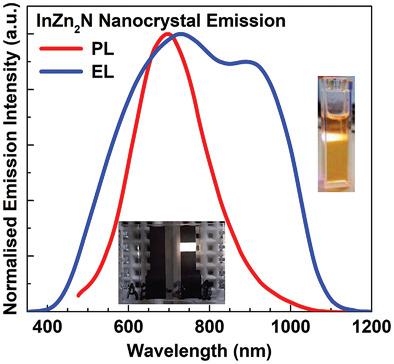当前位置:
X-MOL 学术
›
Adv. Opt. Mater.
›
论文详情
Our official English website, www.x-mol.net, welcomes your
feedback! (Note: you will need to create a separate account there.)
Photo‐ and Electroluminescence from Zn‐Doped InN Semiconductor Nanocrystals
Advanced Optical Materials ( IF 8.0 ) Pub Date : 2020-06-15 , DOI: 10.1002/adom.202000604 Simon M. Fairclough 1 , Peter N. Taylor 2 , Charles T. Smith 3 , Pip C. J. Clark 4 , Stefan Skalsky 4 , Ruben Ahumada‐Lazo 4 , Edward A. Lewis 5 , Daniel J. Tate 6 , Ben F. Spencer 5 , Mary Burkitt‐Gray 1 , Igor Píš 7 , Federica Bondino 8 , Patrick Bergstrom‐Mann 1 , Sadie Carter‐Searjeant 1 , Michael L. Turner 6 , David Binks 4 , Sarah J. Haigh 5 , Wendy R. Flavell 4 , Richard J. Curry 3 , Mark A. Green 1
Advanced Optical Materials ( IF 8.0 ) Pub Date : 2020-06-15 , DOI: 10.1002/adom.202000604 Simon M. Fairclough 1 , Peter N. Taylor 2 , Charles T. Smith 3 , Pip C. J. Clark 4 , Stefan Skalsky 4 , Ruben Ahumada‐Lazo 4 , Edward A. Lewis 5 , Daniel J. Tate 6 , Ben F. Spencer 5 , Mary Burkitt‐Gray 1 , Igor Píš 7 , Federica Bondino 8 , Patrick Bergstrom‐Mann 1 , Sadie Carter‐Searjeant 1 , Michael L. Turner 6 , David Binks 4 , Sarah J. Haigh 5 , Wendy R. Flavell 4 , Richard J. Curry 3 , Mark A. Green 1
Affiliation

|
There is a critical research need for efficient luminescent colloidal nanocrystals, free from cadmium and lead whose toxicity subjects them to usage restrictions, with applications from display devices to biology. Approaches to directly replace cadmium‐based materials have mainly focused on indium phosphide‐based nanocrystals, however these too are subject to concerns over toxicity. Few other alternatives have been found that can compete with the emission range and efficiency of Cd‐ and Pb‐based nanocrystals. Group III‐nitride nanocrystals, and their alloys, offer the exciting potential to tune bandgap energies from the ultraviolet to the near infrared yet a robust route toward efficient luminescent nitride nanocrystals is lacking. Here, the synthesis of photoluminescent indium zinc nitride quantum dots exhibiting tunable emission through the visible to near infrared spectra region, with quantum yields of up to 30% is reported. Capping the nanocrystals with both a GaN and ZnS shell significantly increases air stability and emission quantum yields. A proof‐of‐principle indium zinc nitride nanocrystal light emitting diode is also demonstrated. This work overcomes the significant challenges that have prevented the full exploration of nitride‐based semiconductor nanocrystal development, providing a new system for further exploration as a heavy‐metal free alternative to current state‐of‐the‐art materials.
中文翻译:

Zn掺杂InN半导体纳米晶体的光致和电致发光
迫切需要有效的发光胶体纳米晶体,其中不含镉和铅,其毒性使它们受到使用限制,从显示设备到生物学的应用也是如此。直接替代基于镉的材料的方法主要集中在基于磷化铟的纳米晶体上,但是这些也受到毒性的关注。几乎没有其他替代品可以与Cd和Pb基纳米晶体的发射范围和效率相竞争。III族氮化物纳米晶体及其合金提供了令人兴奋的潜力,可以将带隙能量从紫外线调节到近红外,但仍缺乏通往高效发光氮化物纳米晶体的稳健途径。这里,报道了通过可见光到近红外光谱区域显示可调发射的光致发光铟锌氮化锌量子点的合成,量子产率高达30%。用GaN和ZnS壳包覆纳米晶体可以显着提高空气稳定性和发射量子产率。还演示了原理证明铟锌氮化锌纳米晶体发光二极管。这项工作克服了阻碍全面探索基于氮化物的半导体纳米晶体发展的重大挑战,为进一步探索提供了新的系统,以作为无重金属的替代品来替代当前最先进的材料。用GaN和ZnS壳包覆纳米晶体可以显着提高空气稳定性和发射量子产率。还演示了原理证明铟锌氮化锌纳米晶体发光二极管。这项工作克服了阻碍全面探索基于氮化物的半导体纳米晶体发展的重大挑战,为进一步探索提供了新的系统,以作为无重金属的替代品来替代当前最先进的材料。用GaN和ZnS壳包覆纳米晶体可以显着提高空气稳定性和发射量子产率。还演示了原理证明铟锌氮化锌纳米晶体发光二极管。这项工作克服了阻碍全面探索基于氮化物的半导体纳米晶体发展的重大挑战,为进一步探索提供了新的系统,以作为无重金属的替代品来替代当前最先进的材料。
更新日期:2020-06-15
中文翻译:

Zn掺杂InN半导体纳米晶体的光致和电致发光
迫切需要有效的发光胶体纳米晶体,其中不含镉和铅,其毒性使它们受到使用限制,从显示设备到生物学的应用也是如此。直接替代基于镉的材料的方法主要集中在基于磷化铟的纳米晶体上,但是这些也受到毒性的关注。几乎没有其他替代品可以与Cd和Pb基纳米晶体的发射范围和效率相竞争。III族氮化物纳米晶体及其合金提供了令人兴奋的潜力,可以将带隙能量从紫外线调节到近红外,但仍缺乏通往高效发光氮化物纳米晶体的稳健途径。这里,报道了通过可见光到近红外光谱区域显示可调发射的光致发光铟锌氮化锌量子点的合成,量子产率高达30%。用GaN和ZnS壳包覆纳米晶体可以显着提高空气稳定性和发射量子产率。还演示了原理证明铟锌氮化锌纳米晶体发光二极管。这项工作克服了阻碍全面探索基于氮化物的半导体纳米晶体发展的重大挑战,为进一步探索提供了新的系统,以作为无重金属的替代品来替代当前最先进的材料。用GaN和ZnS壳包覆纳米晶体可以显着提高空气稳定性和发射量子产率。还演示了原理证明铟锌氮化锌纳米晶体发光二极管。这项工作克服了阻碍全面探索基于氮化物的半导体纳米晶体发展的重大挑战,为进一步探索提供了新的系统,以作为无重金属的替代品来替代当前最先进的材料。用GaN和ZnS壳包覆纳米晶体可以显着提高空气稳定性和发射量子产率。还演示了原理证明铟锌氮化锌纳米晶体发光二极管。这项工作克服了阻碍全面探索基于氮化物的半导体纳米晶体发展的重大挑战,为进一步探索提供了新的系统,以作为无重金属的替代品来替代当前最先进的材料。











































 京公网安备 11010802027423号
京公网安备 11010802027423号